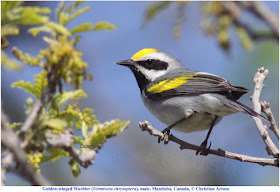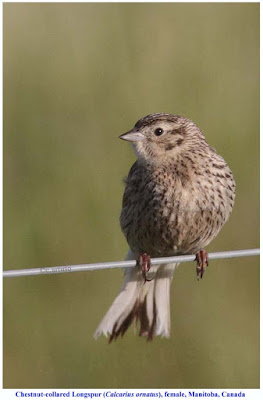The Ellice-Archie and Spy-Hill-Ellice PFRA community pastures are two grassland gems of critical importance to grassland birds in Manitoba. This post is a very brief introduction to their importance for grassland birds and why they are such a key piece for our efforts to retain a grassland ecosystem with a full suite of species (when so many grasslands are under threat of being converted).
The two PFRA community pastures straddle the Manitoba-Saskatchewan border near the town of St-Lazare in Manitoba and Spy Hill in Saskatchewan. As you can see from the Google earth screen shot below, the pastures are large enough that they can be seen from a zoomed out aerial view (this is vitally important for area-sensitive species and also because most of our grasslands are only tiny remnants). You can compare their size with some other visible features such as Riding Mountain to understand their importance. No other grassland in Manitoba is so large.
This detailed image gives you a better sense of the extent of the pastures (a red asterisk is placed near the centre of each pasture). You will also note the white rectangle in Saskatchewan near the pastures which is a large potash mine and another cause for concern in this area:
This zoomed-in image shows how the landscape is structured here. The Assiniboine and Qu'apelle Rivers meet here and both carve deep river valleys. The lower shelf of the river valleys has large and tall riparian deciduous woodlands (also known as gallery forests), the steep slopes have more scrubby oak and aspen vegetation and then, as you climb out of the valleys you are greeted with the vast open prairie on top. This is a glimpse into the way it used to be across the northern prairies before they were ploughed and divvied up. The photo below that also gives a sense of how the river valley climbs to the grasslands on top.
If you'd like to have that feeling of standing in a sea of grass, then this is your place! These three photos give you a sense of the magnitude of the grasslands here.
Unfortunately, some parts of the pastures have been seeded to non-native grasses but there are still large sections of native grasses with high abundance of grassland birds. Some of the key species are introduced below:
These pastures are a key site for the
Chestnut-collared Longspur (
Calcarius ornatus) in Manitoba. This species is highly threatened with red listings as follows:
International listing (IUCN): Near-threatened.
Canadian listing (SARA): Threatened.
Manitoba listing (ESEA): Endangered
In just two days, I counted over 200 Chestnut-collared Longspurs here this summer and that was in only a small section of the southern pasture. Here are three photos of a male, female and their nest with 6 eggs (click back). See also: http://birdatlas.mb.ca/speciesatrisk/species/ChestnutcollaredLongspur/species.htm
These pastures are also important for the
Sprague's Pipit (
Anthus spragueii) in Manitoba. This species is highly threatened with red listings as follows:
International listing (IUCN): Vulnerable
Canadian listing (SARA): Threatened.
Manitoba listing (ESEA): Threatened
In
just two days, I counted over 70
Sprague's Pipits in one section of the pasture and the neighbouring Nature Conservancy of Canada holdings. The density of this species, which is sensitive to edge effects, is unparallelled anywhere else in Manitoba and that is presumably due to the extensive size of the grasslands.
2015 has been a very strange years for grassland bird distribution in Manitoba. Interestingly, we are finding many more
Baird's Sparrows (
Ammodramus bairdii) than usual and in sites further east and north of their recent occurrence in this province. Finding 4 Baird’s Sparrows in these pastures, where they have not been recorded since the 1980s, was very special for me. One of these birds was very close to Nature Conservancy of Canada holdings in this important grassland area. This species is listed as
Special Concern federally in Canada but in considered
Endangered provincially under Manitoba’s Endangered Species and Ecosystems Act.
The above three species are the key grassland specialist species in this pasture; however, other Species At Risk occur here too such as this Short-eared Owl (
Special Concern) photographed quartering over the pasture.
Other Species At Risk such as Burrowing Owl, Ferruginous Hawk and Loggerhead Shrike have been recorded here in the past and could occur again in future if these pastures are safeguarded. Some other important grassland birds that are not (yet) considered Species At Risk such as Grasshopper Sparrow (photo below) are also found here in good numbers.
Of course, many other birds make their home here: raptors include Red-tailed Hawk, Swainson's Hawk and
Northern Harrier (photo below)
Upland-breeding shorebirds that breed in this pasture or close to it include the
Marbled Godwit (two photos below of these large shorebirds defending their territory)
The Upland Sandpiper also breeds here in good numbers:
... as does the Willet (seen here perched on a pasture fence post).
This is also one of the very best places in the whole province of Manitoba to see
Mountain Bluebirds. Eastern Bluebirds are very common in Manitoba but Mountain Bluebirds are becoming increasingly rare and difficult to see (perhaps due in part to Eastern Bluebirds expanding westward with the placement of bluebird boxes). In this part of the world, the
Mountain Bluebird is a prairie species to watch!
Exploring the river bottom forest and the shrubby hillside of course will produce a much more comprehensive list of species; however this area is most significant for threatened grassland birds. We are watching to ensure these pastures remain as pastures and continue to convey the great benefits to the prairie ecosystem that they have for so long! For more information, see:
http://www.gov.mb.ca/conservation/cdc/pdf/stlazare.pdf



























































